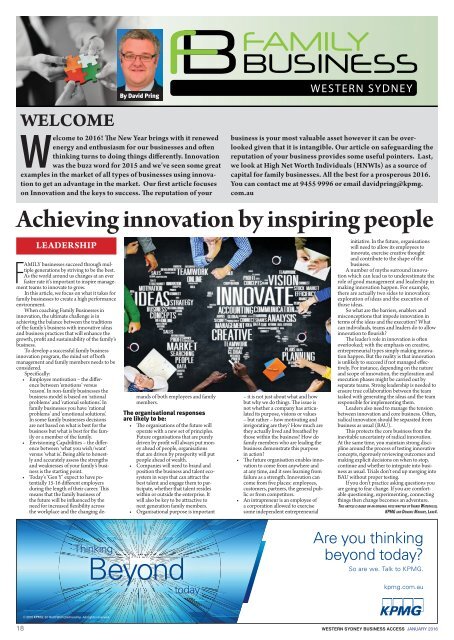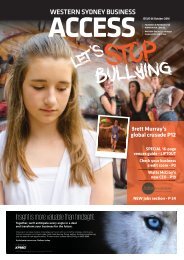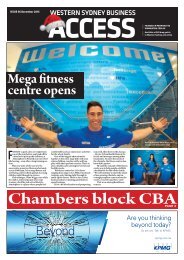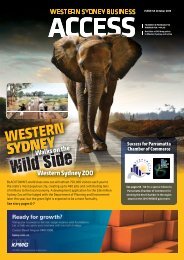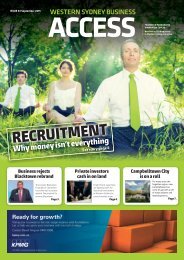ANITA COBBY
WSBA January 2016 Edition
WSBA January 2016 Edition
You also want an ePaper? Increase the reach of your titles
YUMPU automatically turns print PDFs into web optimized ePapers that Google loves.
WELCOME<br />
By David Pring<br />
Welcome to 2016! The New Year brings with it renewed<br />
energy and enthusiasm for our businesses and often<br />
thinking turns to doing things differently. Innovation<br />
was the buzz word for 2015 and we’ve seen some great<br />
examples in the market of all types of businesses using innovation<br />
to get an advantage in the market. Our first article focuses<br />
on Innovation and the keys to success. The reputation of your<br />
BF<br />
FAMILY<br />
BUSINESS<br />
WESTERN SYDNEY<br />
business is your most valuable asset however it can be overlooked<br />
given that it is intangible. Our article on safeguarding the<br />
reputation of your business provides some useful pointers. Last,<br />
we look at High Net Worth Individuals (HNWIs) as a source of<br />
capital for family businesses. All the best for a prosperous 2016.<br />
You can contact me at 9455 9996 or email davidpring@kpmg.<br />
com.au<br />
Achieving innovation by inspiring people<br />
LEADERSHIP<br />
FAMILY businesses succeed through multiple<br />
generations by striving to be the best.<br />
As the world around us changes at an ever<br />
faster rate it’s important to inspire management<br />
teams to innovate to grow.<br />
In this article, we focus on what it takes for<br />
family businesses to create a high performance<br />
environment.<br />
When coaching Family Businesses in<br />
innovation, the ultimate challenge is in<br />
achieving the balance between the traditions<br />
of the family’s business with innovative ideas<br />
and business practices that will enhance the<br />
growth, profit and sustainability of the family’s<br />
business.<br />
To develop a successful family business<br />
innovation program, the mind set of both<br />
management and family members needs to be<br />
considered.<br />
Specifically:<br />
• Employee motivation – the difference<br />
between ‘emotions’ versus<br />
‘reason’. In non-family businesses the<br />
business model is based on ‘rational<br />
problems’ and ‘rational solutions’. In<br />
family businesses you have ‘rational<br />
problems’ and ‘emotional solutions’.<br />
In some family businesses decisions<br />
are not based on what is best for the<br />
business but what is best for the family<br />
or a member of the family.<br />
• Envisioning Capabilities – the difference<br />
between ‘what you wish/want’<br />
versus ‘what is’. Being able to honestly<br />
and accurately assess the strengths<br />
and weaknesses of your family’s business<br />
is the starting point.<br />
• Today’s ‘Gen Y’ expect to have potentially<br />
15-16 different employers<br />
during the length of their career. This<br />
means that the family business of<br />
the future will be influenced by the<br />
need for increased flexibility across<br />
the workplace and the changing demands<br />
of both employees and family<br />
members.<br />
The organisational responses<br />
are likely to be:<br />
• The organisations of the future will<br />
operate with a new set of principles.<br />
Future organisations that are purely<br />
driven by profit will always put money<br />
ahead of people, organisations<br />
that are driven by prosperity will put<br />
people ahead of wealth.<br />
• Companies will need to brand and<br />
position the business and talent ecosystem<br />
in ways that can attract the<br />
best talent and engage them to participate,<br />
whether that talent resides<br />
within or outside the enterprise. It<br />
will also be key to be attractive to<br />
next generation family members.<br />
• Organisational purpose is important<br />
– it is not just about what and how<br />
but why we do things. The issue is<br />
not whether a company has articulated<br />
its purpose, visions or values<br />
– but rather – how motivating and<br />
invigorating are they? How much are<br />
they actually lived and breathed by<br />
those within the business? How do<br />
family members who are leading the<br />
business demonstrate this purpose<br />
in action?<br />
• The future organisation enables innovation<br />
to come from anywhere and<br />
at any time, and it sees learning from<br />
failure as a strength. Innovation can<br />
come from five places: employees,<br />
customers, partners, the general public<br />
or from competitors.<br />
• An intrapreneur is an employee of<br />
a corporation allowed to exercise<br />
some independent entrepreneurial<br />
initiative. In the future, organisations<br />
will need to allow its employees to<br />
innovate, exercise creative thought<br />
and contribute to the shape of the<br />
business.<br />
A number of myths surround innovation<br />
which can lead us to underestimate the<br />
role of good management and leadership in<br />
making innovation happen. For example,<br />
there are actually two sides to innovation:<br />
exploration of ideas and the execution of<br />
those ideas.<br />
So what are the barriers, enablers and<br />
misconceptions that impede innovation in<br />
terms of the ideas and the execution? What<br />
can individuals, teams and leaders do to allow<br />
innovation to flourish?<br />
The leader’s role in innovation is often<br />
overlooked; with the emphasis on creative,<br />
entrepreneurial types simply making innovation<br />
happen. But the reality is that innovation<br />
is unlikely to succeed if not managed effectively.<br />
For instance, depending on the nature<br />
and scope of innovation, the exploration and<br />
execution phases might be carried out by<br />
separate teams. Strong leadership is needed to<br />
ensure true collaboration between the team<br />
tasked with generating the ideas and the team<br />
responsible for implementing them.<br />
Leaders also need to manage the tension<br />
between innovation and core business. Often,<br />
radical innovation should be separated from<br />
business as usual (BAU).<br />
This protects the core business from the<br />
inevitable uncertainty of radical innovation.<br />
At the same time, you maintain strong discipline<br />
around the process of testing innovative<br />
concepts, rigorously reviewing outcomes and<br />
making explicit decisions on when to stop,<br />
continue and whether to integrate into business<br />
as usual. Trials don’t end up merging into<br />
BAU without proper testing.<br />
If you don’t practice asking questions you<br />
are going to fear change. If you are comfortable<br />
questioning, experimenting, connecting<br />
things then change becomes an adventure.<br />
THIS ARTICLE IS BASED ON AN ORIGINAL PIECE WRITTEN BY INGRID WATERFIELD,<br />
KPMG AND DOMINIC MAHONY, LANE4.<br />
Thinking<br />
Beyond<br />
today<br />
Are you thinking<br />
beyond today?<br />
So are we. Talk to KPMG.<br />
kpmg.com.au<br />
© 2015 KPMG, an Australian partnership. All rights reserved.<br />
18 WESTERN SYDNEY BUSINESS ACCESS JANUARY 2016


